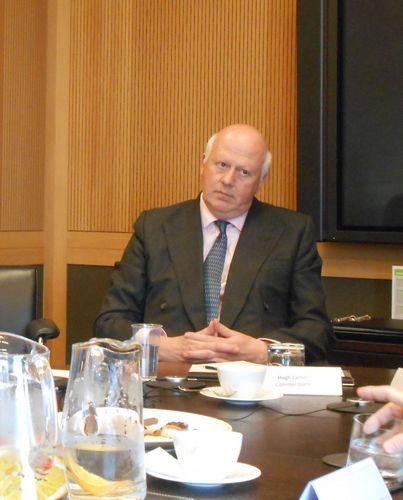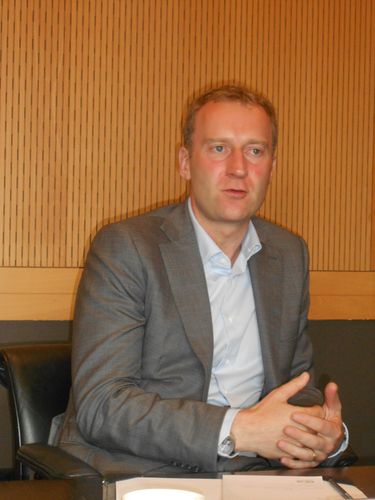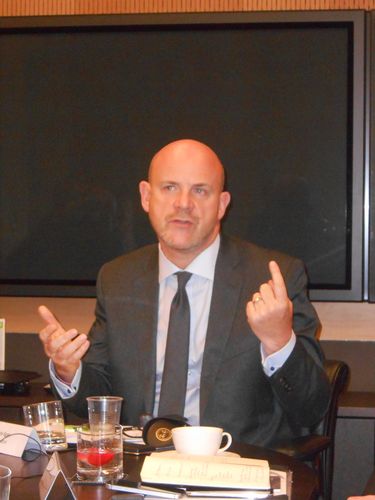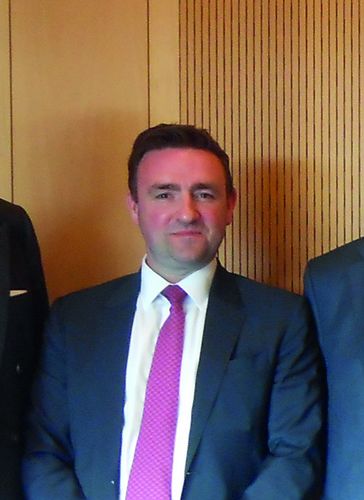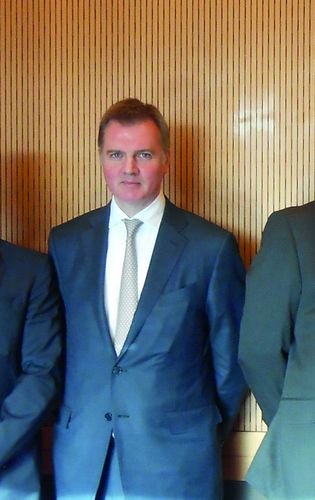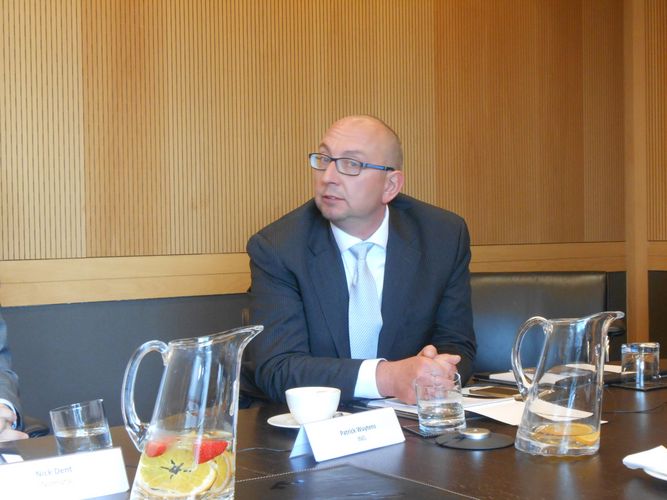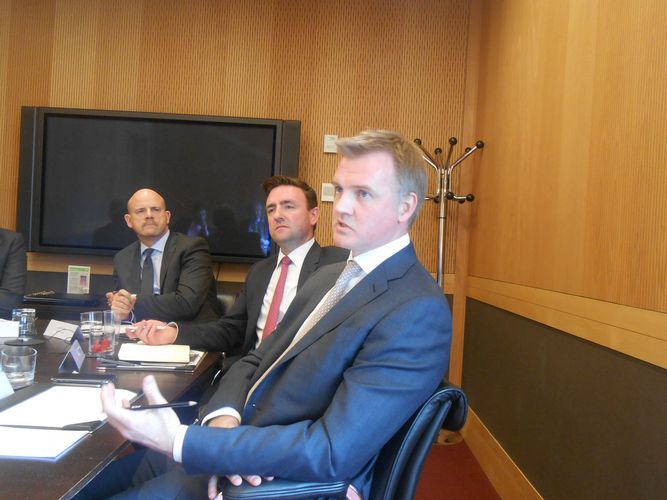Primary Debt Market Conclave
On the occasion of the International Capital Market Association’s Annual General Meeting and Conference in Dublin in May 2016, IFR convened members of ICMA’s Primary Market Practices Committee to discuss some of the key issues facing the debt syndicate and capital markets communities in the midst of regulatory upheaval and amid a volatile and extraordinary set of market circumstances.
We dubbed the event IFR’s Primary Debt Market Conclave, to convey its flavour as a closed-session thought-leadership event. Martin Egan, committee chairman (and global head of primary markets and origination at BNP Paribas) attended, along with Hugh Carter, head of credit syndicate at Commerzbank; Patrick Wuytens, head of high-grade syndicate at ING; Nick Dent, head of EMEA and AEJ syndicate at Nomura; Sean Taor, head of European DCM at RBC Capital Markets; and Spencer Maclean, head of Europe and Americas capital markets at Standard Chartered Bank.
It was a highly experienced group of individuals that has seen the market through many cycles over many years. Between the end of the ICMA board meeting at the Dublin convention centre on May 18 and ICMA’s opening reception at the Irish Museum of Modern Art at the Royal Hospital Kilmainham, we had a lively discussion that took in a number of key themes.
Beyond the key role ICMA’s primary market practices committee plays in setting robust standards and high standards of conduct, injecting cross-market and cross-regional transparency, consistency and accountability into new issue execution and connecting different elements of the ecosystem, our discussion took in the role of syndicate in today’s marketplace (including dealing with the vexed subjects of new issue allocations and order inflation); secondary liquidity; and electronification, including the extent to which elements of the syndication process could be digitised as technology solutions in investment banking become increasingly ubiquitous.
Investment banks may be paid by issuers, but to make primary transactions work syndicate needs to work hand-in-hand with investors to make sure transactions are concluded on terms that work for both sides of the equation. Successful syndication – which has long since ceased to be a function of principal hard underwriting by bookrunners – derives today from a process of information-gathering, transparency, timely information-sharing and efficient dissemination of order book information.
There was a sense among the speakers that transparency and information-sharing are a little too weighted to the issuer community and that the buyside needs to play catch-up and improve transparency around elements such as true demand and price sensitivity.
Our panel strongly believes that syndication continues to be an art rather than a science and not always as easy as it looks. That may well sound like a cliché but that doesn’t make it less true. It’s also undeniable that while secondary markets are in effect broken as liquid transfer channels, that hasn’t prevented the primary market from being open and efficient.
The discussion touched on the issue of technology. As an issue of art rather than science, syndication continues to be a matter for judgement rather than algorithms. Even so, the syndicate community is embracing solutions that can help make the process more efficient. Fully digital solutions, however, will probably remain beyond the capability of IT, on the basis that syndicate is ultimately about making sure the right people get the right bonds and that it reflects the requirements of the issuer.
By the same token, there’s less than overwhelming support for corporate bond standardisation, particularly away from the world’s programmatic mega-borrowers.
On ICMA’s primary market practices committee
Martin Egan
“Regulation is truly changing today’s marketplace. The value of us coming together as the ICMA Primary Market Practices Committee is to help shape the market we work in. Regulators have given a very precise view on what we have to do globally, and we’ve all learned lessons from what’s been going on around FX and Libor.
We want to make sure that the high standards we have for primary markets are robust and the best we can have, in the context of a very technical market.
No specific market segment is the same as the next; so we try to hone the different expertise of local marketplaces to come up with something that’s sensible and workable. We aim to connect. That’s an important differential that ICMA can offer: we have borrower communities for SSA, corporates and FIG; and we have the Asset Management and Investors Council to capture the investor view.
The driving factor for primary markets specifically is how regulation – and especially conduct – affects what we do, with a very clear focus on two specific points. One is the allocation process, which is very actively discussed; the other is the handling of material non-public information (MNPI) in terms of what we can say to investors around specific transactions and what we can communicate along the chain of execution.
The role of the Primary Market Practices Committee, which numbers almost 50 people, is to make sure that we have consistency as a marketplace. Across the spectrum of banks, borrowers and investors, we have to make sure that we have standards and guidance the marketplace understands in every aspect. We want to make sure that every member of that committee and their institutions understand the regulatory backdrop we’re in and what we feel are fair market standards for all of us to follow.
We want to be sure that the standards we have around deal execution and the discussions around MNPI are appropriate for all users and that there isn’t one rule for one and a different rule for somebody else.
As ICMA, all we can do is guide but we want to make sure that the primary markets are open, and transparent, and work hand-in-hand with the new regulatory environment. To be clear: it’s not banks working hand-in-hand; it’s working hand-in-hand with all market participants including regulators. One thing that has always surprised me, even with the level of engagement we’ve had, is the lack of understanding around market process – ie, borrowers understanding what investors want; what investors expect from the process etc. We want to make sure that improves.”
Nick Dent
“We’re incredibly lucky to have an umbrella organisation like ICMA. When we look at the implementation of regulations, it’s a push-down process with a lot of theory and decisions are taken by senior management but not with a lot of guidance around practical application. We take the theory and put it into practice. And the outcome of discussions we have at ICMA needs to be relevant to everyone involved [in the deals execution process].
Markets are always under pressure. With current central bank actions, the pressure points are increased so you need a very clear, very concise process because even if the lead times on deals may be long in the background, the execution time can be extremely narrow.
If you don’t have a clear process and there are three, four, five-plus banks on a deal pushing through multi-billion size in in a matter of hours, things can fall over very quickly. This is where we spend a lot of time talking: process. It doesn’t matter whether market levels are Libor minus 10bp or plus 10bp: process and clarity matter.”
Patrick Wuytens
“Given the regulatory framework we operate under, we need to take care of everybody. We need to take care of issuers but we also need to make sure that investors are allocated what they want. We are not a lobby group but I’m impressed that even though we don’t impose our guidelines on market practitioners, those guidelines have been respected. That’s important for our community. We’re trying to find the best solution for the market, to guide us all through volatile conditions.”
On the role of syndicate; allocation challenges; order inflation. Whose side is syndicate on?
Spencer Maclean
“We’re paid by the issuer but we work with issuers and investors. If you work only for one side, you’re never going to bring transactions successfully to market. If an issuer’s desires are removed from where the investors are, or vice versa, transactions aren’t going to happen. The role of the syndicate desk is to advise and guide.
The process can take place in a matter of hours or over a week if you’re roadshowing a transaction but it’s an information-gathering exercise. By constantly sharing information, you’re able to guide issuers. If an issuer doesn’t want to do a transaction, you’re not going to push him to get it done because it’s not going to be in his best interest.
By and large, syndicate desks know the issuers very well. The point about disseminating order book information in a prompt and efficient manner and all going at the same time is it stops mismanagement. In the past, bond salespeople would encourage investors to inflate their orders; that kind of behaviour has all been left behind.
But it’s interesting to note that there’s no regulation around how investors place orders. I think it would be interesting to see the buyside apply the same amount of effort that we have made at the intermediary level. There have been grumbles from the buyside and we’ve taken them on board in our behaviour and how we give out information. But it would be interesting to see investors undertake the same exercise their end.”
Sean Taor
“It all comes down to working with regulators, issuers and investors and being accountable. Applying best practice and standardisation across banks, issuers and countries clears up some of the smoke and mirrors around the process.
Banks are far more engaged on the syndicate desk with investors than they’ve ever been, and issuers have more information from those investors than they ever had but an issuer can’t issue if investors won’t buy.
For example, when the ECB started buying covered bonds in primary, they distorted the market very quickly and real-money investors took a step back. The market stopped issuing and levels reset to where the ECB and investors were happy buying again. I think the ECB, investors and banks all learned from that.
Investors are concerned primarily about where spreads will go. One obvious downside of the QE that the ECB has put forward is that savers are no longer getting much income in fixed income. We don’t know where the market will go but it will have to strike a balance. Part of the job of syndicate is to find that balance, and to guide issuers around where we think the real-money investors will buy, even if that means back from the secondary levels.
Issuers are receptive to syndicate guidance around pricing levels. The more frequent issuers are by definition in the market very often but even some of the rare corporate issuers take a long-term view about where they want their debt to be, who will hold it, and performance. They’re concerned about some of the noise they hear from investors, particularly around allocation.
Conduct risk is clearly at the forefront of everyone’s minds. Over the years, the educational process between issuer, investor and the syndicate desk has gone up immeasurably. Most investors, particularly the larger ones who would typically have felt unhappy about allocations, now understand the process far better. It used to be a bit of a black box: you put a number in, you got a number out, and there wasn’t much discussion before or afterwards. Now, there’s an awful lot of discussion before, during, and after.”
Hugh Carter
“Today’s market is an extremely negotiated market, compared to five to 10 years when the concept of underwriting was there. There is a much better understanding today about how you reach fair value on transactions, how you work out new issue premiums and get to points where transactions clear for the benefit of both issuers and investors.
What we endeavour to do is create transparency at the level of the people who actually do the trades. By doing the trades, we are expanding transparency. We communicate book sizes in an efficient and timely fashion and at the right time; we make sure that statistics are sent out after the transactions. We give people comparable levels and we make sure documentation is sent out on the announcement.
Everything is there to make sure investors can make qualified judgements about whether they should buy, and then afterwards that they can actually see what the results of that transaction are.
On the issue of best-practice dissemination, the FCA drives UK banks and the UK market but because ICMA’s Primary Market Practices Committee is configured of many different bank nationalities, best practices have spread across Europe without local regulators having to do exactly the same thing as the FCA.
A trade could have five different nationality banks on it but everybody is working towards the practices that we work to within the London marketplace.”
Martin Egan
“From the outside, the process around deal execution may look simple but it is far from easy. Allocation is an art not a science. With the regulatory environment we’re in, the downside for banks to get an allocation process wrong is quite pronounced and we’ve all had cases where there’s been frustration.
What we try to push forward is fairness in the process and as much transparency as we can, which will be assisted by MiFID and other rules and regulations. Regarding the role of an underwriting bank in a deal, there’s a very fine line in terms of who you work for. Legally we work for the borrower; we underwrite and we get paid a fee.
But we’re at all times trying to match the needs and requirements of both sides. Sometimes it’s a challenge because not all sides are fully transparent. With borrowers, the marketplace is more demanding of transparency – ie, what’s their final deal size, what’s their price guidance?
With investors we want to know their real order; we don’t want to see order inflation and we want to get their price flexibility. The end result is in most instances very satisfactory but it’s undeniable that some investors are very powerful because of their size and scale. What syndicate managers have to do – with a very strong element of fairness, understanding the investment community and what the borrower’s goals are – is to allocate a deal in a fair and appropriate fashion.
We haven’t been helped, historically, with order inflation. I think that is going to improve over time as regulation changes. I think the industry does a good job at the moment but what we need to do better is make sure that all parties understand the specific roles that everyone has in a deal and why we allocate the way we do.
Matching the goals of borrowers and investors can be daunting. That’s the hardest part of the day-to-day job. That’s why with ICMA we try to make sure in light of regulation and conduct that our engagement offers sufficient guidelines to allow people to work in an appropriate fashion.
Sometimes you encounter situations where both sides of the equation end up immensely frustrated. Borrowers moan that they left basis points on the table while investors complain about being under-allocated for their size and scale. You have to listen to all counterparts.
The big difference now is that we all have policies and procedures around everything we do: including how to allocate a deal and how to stabilise a deal. Through ICMA we have full engagement: we have our primary market practice, we have secondary market practice; legal and docs, compliance and borrower forums. ICMA is a collective in many ways and our role is to connect that collective.”
Patrick Wuytens
“Accounts generally only put in orders for the amount they want. Obviously, some firms don’t do that and it’s very tough to assess that. But I rarely see, certainly from the big accounts, [rampant] order inflation. We have had instances where accounts get bonds and you just know it’s too much. But that’s more something you’d see in the past.
We’re putting a lot of effort into transparency, trying to keep everybody together in this volatile market. I agree, it would be great at an investor level if there were some rules. I have the impression that it’s starting to happen. Are they doing it the same speed as us? Not yet.
On the issue of syndicate advice, we’ve been in this market for many years and it’s a matter of experience. The more volatility we’ve seen, the more issuers listen to syndicate advice. We have experience of manoeuvring through volatile market conditions and trying to bring investors and issuers together. They do listen more to our advice, and we’re creating equilibrium between issuers and investors to the point where we can explain to an issuer what the right levels are.
Our role is not to fight volatility; we’re here to manage volatility, to manage the primary flow and to advise issuers about market conditions. If the market is volatile, we will give our fair judgement on what is possible and what we think the price is.”
Nick Dent
“This is a highly competitive market. We fight each other to get trades but the end result is everyone working together to get the best results. On the allocation process, we’ve had a fixed income bull market for a number of years where issuers have been able to dictate terms and where investors have complained about allocations or other aspects of the execution process.
Recently, there’s been a lot more volatility and not every trade has benefited from multiple oversubscription. That’s where you start to see investors pare back in terms of inflating orders. The market does self-level at a certain point.”
On secondary liquidity
Martin Egan
“European capital markets are not as adaptable as the US marketplace; it’s better than it used to be but we haven’t reached the point like the US where the market is open pretty much every day of the year.
European primary markets can now evolve to most market conditions. That’s a big positive. But we now have a divide between a buoyant, robust and healthy primary market; and broken secondary markets. Investors do understand that, however, and you’re beginning to see a change in their investment strategy on the basis that they can’t aggressively trade securities in a short timeframe.
I do think you will see further deterioration of secondary market liquidity, but banks managing new issues still need the flow of intelligence derived from secondary credit market valuations. We still need to trade bonds as it forms part of our broader client service that also includes derivatives and risk hedging. But it’s undeniable that you will trade with more constraint than you’ve done in the past.
With central bank support in play, borrowers in the short term will still get the best funding opportunities they’ve probably ever seen. For corporate borrowers, the risks are limited. Longer term we have huge challenges ahead. When at some point in the future you start to see the dramatic support given to the marketplace unwind, there’ll be many factors to manage.
That is where there is probably an element of short-sightedness, where we’re not thinking about the marketplace in five or 10 years’ time. Today’s marketplace is ebullient and buoyant, even in the context of broken secondary market liquidity but when investors truly have to sell, we will have dramatic price swings and, most importantly, a pronounced increase in the cost of liquidity for borrowers.
Then you will start to see regulation changing to be more conducive to a full-blown market. But for the time being, primary focuses exceptionally well with broken secondary markets.
On the back of all of this, what we are seeing is banks making decisions about where they want to be, be it in strategic announcements, be it in deciding, say, to exit trading in certain government bond markets. We’re seeing an evolution that in the longer term will lead to fewer players in specific marketplaces.
Primary, however, is the window into a bank, so primary remains robust. Once upon a time, as per Oliver Wyman, primary had a multiplier effect: for every euro of revenue you’d make from primary you’d make two or three from trading derivatives and other products or providing other services. These days, I think at best now you’ll make 50 cents of ancillary business from every euro in primary. That’s a big challenge, so I think the models will have to evolve.”
Sean Taor
“For some banks, that one euro from primary now begets minus one; some parts of secondary trading are just not profitable. With bank funding costs generally higher, with the return you get on the bonds you hold, negative rates and the cost of balance sheet, a lot of businesses just aren’t as profitable.
Investors understand that; it comes down to having a more open dialogue around what each bank can do and what it can’t do. Many banks can’t be everything to everyone.”
Spencer Maclean
“Investors are still grumbling about the lack of secondary liquidity but it’s regulation that’s forcing the hands of banks to step away from providing that liquidity. I do think the issue has been overdone, but in any case it’s not really hurting the primary markets.
It is hurting secondary market revenues and it’s hurting investors, who complain they can’t get trades away. However, it’s not impacting the ability of the primary market to function. Once upon a time it would have done. Back in the days when we were underwriting and taking paper, when the market was less efficient, illiquidity in the secondary market or the opaqueness of the secondary market to get pricing was a problem.
Now that we’re using the pot system and we’re engaged with both sides and we’re in an information-gathering process, the span of investor appetite is very clear to an issuer, as opposed to hearing from a syndicate guy what he’s prepared to buy. The primary market has evolved hugely and it’s managed to combat illiquidity in the secondary market and still be very efficient at getting deals away.
Without the secondary market, a borrower’s issuance curve would become incredibly scattered, and everyone would start to lose focus on where it is. Investors will start to see value at very different levels so the range in which they are prepared to buy a particular issue becomes very broad. That hurts the issuer because he then doesn’t know what to do. Which investors does he listen to?
The process as it stands at the moment of gathering information, bringing everyone together, demonstrating the size of the order book, saying where the range of an issue is going to be, and ending up at a final price that suits the issuer and the investor is a very efficient process even if it’s old-fashioned.”
Hugh Carter
“Credit markets have never been that liquid; there have been good times and bad times and we’ve always moaned about that. But the model that people are potentially going to adopt is more of what you might have seen 10, 15 or 20 years ago, which is matching buyers and sellers by having a sales-trading desk that is truly working to move bonds between investors.
Obviously, if everybody’s going one way, that’s not a particularly easy solution but whenever markets have that change in sentiment there’s always a new level at which people will come back in again. It doesn’t always go one way.
Are the US credit markets always that liquid? I don’t think there’s any real difference to what we have in Europe, other than they also have some extremely large issues. Electronic trading has assisted in creating some form of liquidity because there is a true pricing mechanism on all banks’ electronic platforms. There are things to be positive about on trading.”
Patrick Wuytens
“Long-term holders are important in illiquid bond markets; short-term players can disrupt the market quite quickly. If one bond has a problem, the next one will struggle as well so we will have much more volatility in primary markets too.
We need to find a transparent balance between allocating to long-term holders and short-term players as we do need that liquidity but that is the art we provide. I still believe the secondary market is important and is still being used even if it’s illiquid. We can also provide a level of judgement on that illiquidity.
Some people say: “that is an illiquid bond because it’s a US$300m deal; and that is not an illiquid bond, because it’s a US$5bn trade” but it may have nothing to do with size. That again speaks to syndicate judgement because we can say: “that is a high-coupon bond and that is a current-coupon bond”.
It’s our role to find the right balance between myth and reality. We do need that secondary market. At the end of the day, when we talk about positive and negative new issue premiums, they’re always based on the secondary market even if it is illiquid, so it has its importance.”
On electronification of trading and syndication
Nick Dent
“Primary debt markets haven’t evolved in the way so many other market segments have evolved in terms of fintech: look, by comparison, at what’s happened to the likes of FX or equities. Our market is incredibly manual and old-fashioned. We are starting to see a number of players creep in around the edges; there’s nothing coming in a big block but there are a lot of smaller start-up companies looking at how they can make things more efficient.
That can only grow, and it’s absolutely welcome. If we have this conversation in 10 years’ time, we’ll probably be acting in an advisory capacity. I’m hoping there will be elements of being able to put processes like allocation through a digital platform. We haven’t seen any of that in our industry. We still sit there and allocate every single line item.”
Hugh Carter
“I don’t think electronic platforms can offer the right type of execution for issuers. What we effectively have to do, through all our promises and practices, is to make sure the right people get the right bonds, which reflect the requirements of the issuer.
If you had a straightforward auction platform or some form of straight-line algorithm, you would end up with potentially much more shorter-term holders owning securities and the main players actually not getting involved in primary. You’d have much more volatility as a result of that. That said, we could definitely do with more technological solutions in terms of process efficiency and that’s where we’re going.”
Patrick Wuytens
“Technology can certainly improve in our market but understanding liquidity and providing market judgement can never be achieved with an IT system.”
Martin Egan
“I still see a role for a syndicate manager in 10 years’ time. I also see a role for DCM, but perhaps a different sort of role: less rainmaker and more commoditised execution person. But we do need to automate the distribution process much more aggressively, which is theoretically the plan but we are moving at a sluggish pace.
If you have reams of salespeople in different jurisdictions, they need to be put to work doing what is relevant for the client base and your overall franchise.
If we automate the execution of new issues and order book-building, we will need much less resources and it could actually be much more efficient. From a conduct perspective, you’d raise the bar in terms of applicability in the context of making the market a better place. But because of confidentiality, because of IT inconsistency, we’re lagging. We will get there as a primary business, but it will be some time.
A lot of people are fighting against it. Even investors are saying: “we don’t want this to become too automated”. If you automate a book-building process you lose that precise colour around your demand for a deal.”
On corporate bond standardisation
Spencer Maclean
“It’s not what the issuer wants. We’re going to carry on seeing diversified markets. There are going to be new products that come through. Green bonds are on everyone’s lips; the Panda bond market is going to open up and be huge.
If you are forcing an issuer into European markets in certain windows, the rest of the world’s markets are not going to do that; they’re going to welcome them with open arms. So, it will actually damage not just these markets; it will damage issuers.”
Hugh Carter
“An issuer doesn’t work like that. An issuer has specific funding requirements; he’ll want to have a smooth redemption profile. He doesn’t want to be told that he has to issue at five, 10, and 30 years. In fact, a lot of issuers come to the euro-denominated market because they are able to issue in odd maturities and get that flexibility.
Issuers will just push back and say: “if we want €550m, we’ll do €550m. We’re not going to do a €1bn trade just because we’re told to do so; we don’t need €1bn”. If you were forced to raise money you didn’t need, what would you do with it in today’s market? You’d have to put it on negative interest rates.”
Nick Dent
“I think there are some merits to it. I can see the way that people are trying to put some science and regularity into the market. We’ve had it before in many other different markets; the US GSEs spring to mind, where Fannie Mae/Freddie Mac have specific windows.
You can see it with a US$50bn–$60bn funder every year in the government market because they’ll take the rough with the smooth. A lot of the investor feedback from that is positive and they can gear around it and make sure that they’re set up accordingly.
It’s very hard to overlay that model on corporate bond or other markets but I can see the broad understanding. If we’re trying to automate a market, wouldn’t it be fantastic if you have this almost constantly offerable five-year security on this day, and then on another day it’s a 10-year?
You can automate that very, very quickly, so I can see that if you really want to get to the far end of fintech and the way the market could be highly automated, that will be the route to go. But you will lose a lot of balance in the market and judgement on the way.”
Martin Egan
“Standardisation has been a very interesting discussion. A lot of big investors have been very supportive of it, which we understand. From the issuer perspective, away from the very frequent borrowers, we need flexibility.
We may get to a point where standardisation is less pronounced than investors want but where borrowers do want to show more flexibility. At the moment the two are poles apart. What’s made our market one of the best markets in the world is its flexibility. If you standardise it or if you make it too rigid, it will lose its attraction.”
To see the digital version of this special report, please click here
To purchase printed copies or a PDF of this report, please email gloria.balbastro@thomsonreuters.com

